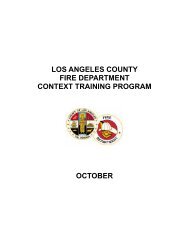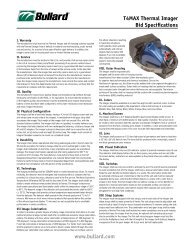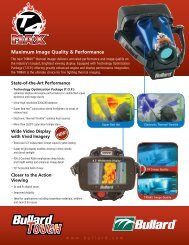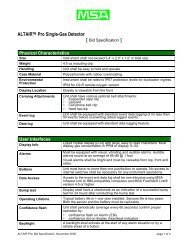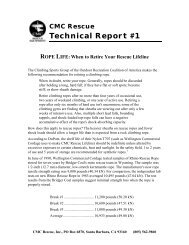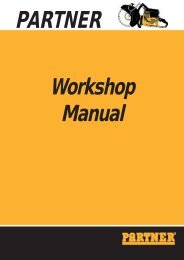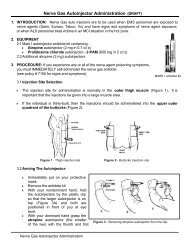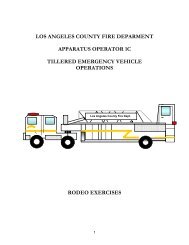PARTNER K950 Operators Manual 1998.pdf
PARTNER K950 Operators Manual 1998.pdf
PARTNER K950 Operators Manual 1998.pdf
Create successful ePaper yourself
Turn your PDF publications into a flip-book with our unique Google optimized e-Paper software.
CUTTING BLADES<br />
SAFETY INSTRUCTIONS<br />
Abrasive blades<br />
The cutting material in an abrasive blade consists of abrasive<br />
corn that is held together by an organic bonding agent.<br />
”Reinforced blades” are made up of a fabric or fibre base that<br />
prevents total breakage at maximum working speed if the blade<br />
should be cracked or damaged. (The term reinforced does not<br />
refer to those cutting blades that are only reinforced around the<br />
flange).<br />
A cutting blade’s performance is determined by the type and<br />
size of abrasive corn, and the type and hardness of the bonding<br />
agent.<br />
Characteristics that give the blade a shorter service life and<br />
greater cutting capacity are said to make the blade ”softer”. A<br />
blade with a longer service life and slower cutting capacity is a<br />
blade with a ”harder” effect.<br />
General<br />
Cutting blades are available in two standard designs; abrasive<br />
blades and diamond blades.<br />
High quality cutting blades are normally more economical.<br />
Lower quality cutting blades usually have an inferior cutting<br />
capacity and shorter service life, which results in higher cost per<br />
processed material.<br />
ABRASIVE BLADES, TYPES AND USES<br />
!<br />
WARNING!<br />
A cutting blade may burst and cause injury<br />
to the operator.<br />
Blade<br />
type<br />
General<br />
characteristics<br />
Use<br />
Material<br />
Water cooling<br />
High speed portable tools<br />
Cutting blades of the make Partner are manufactured for<br />
portable, high speed, power cutters. If other makes of cutting<br />
blades are used, ensure the blades comply with all the<br />
directives and requirements attributed to the specific type of<br />
power cutter.<br />
!<br />
WARNING!<br />
Never exceed the maximum working speed of<br />
a cutting blade.<br />
Special blades<br />
Some cutting blades are designed for stationary equipment and<br />
for use with attachments. These types of cutting blades must<br />
not be used on portable, power cutters.<br />
Concrete<br />
Metal<br />
Universal<br />
usage,<br />
economical<br />
Unbeatable for<br />
steel (not<br />
suitable for<br />
concrete, etc.)<br />
Concrete,<br />
asphalt,<br />
stone,<br />
brickwork,<br />
cast iron,<br />
aluminium,<br />
copper,<br />
brass, cables,<br />
rubber, etc.<br />
Steel, steel<br />
alloys and<br />
other hard<br />
metals.<br />
Increases the<br />
blade’s service<br />
life. Reduces<br />
dust formation.<br />
Recommended.<br />
Reduces cutting<br />
capacity NOT<br />
recommended.<br />
!<br />
WARNING!<br />
Never use a cutting blade for any other<br />
purpose than that it was intended for.<br />
Always contact local authorities and make sure you are<br />
following applicable directives.<br />
10 – English



